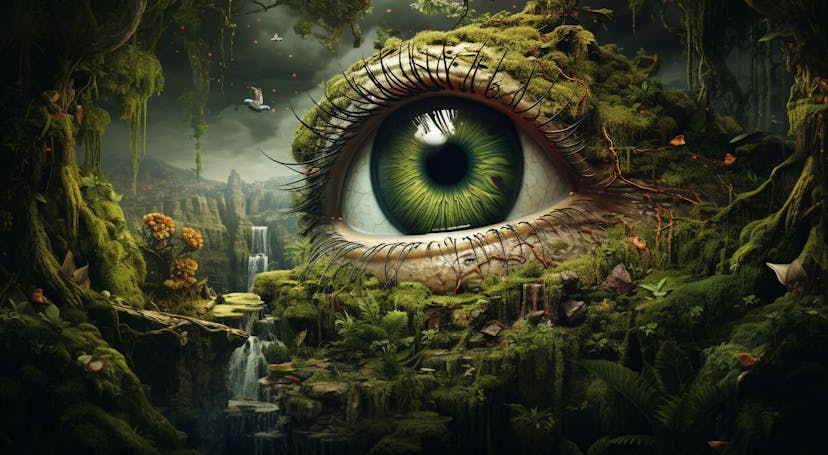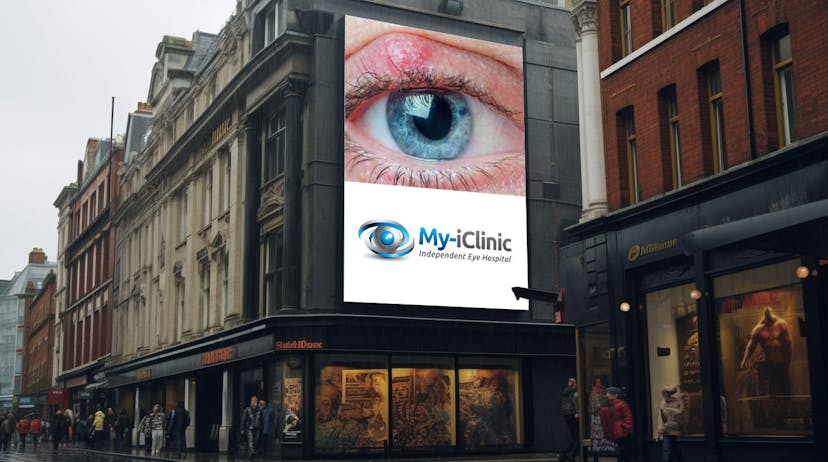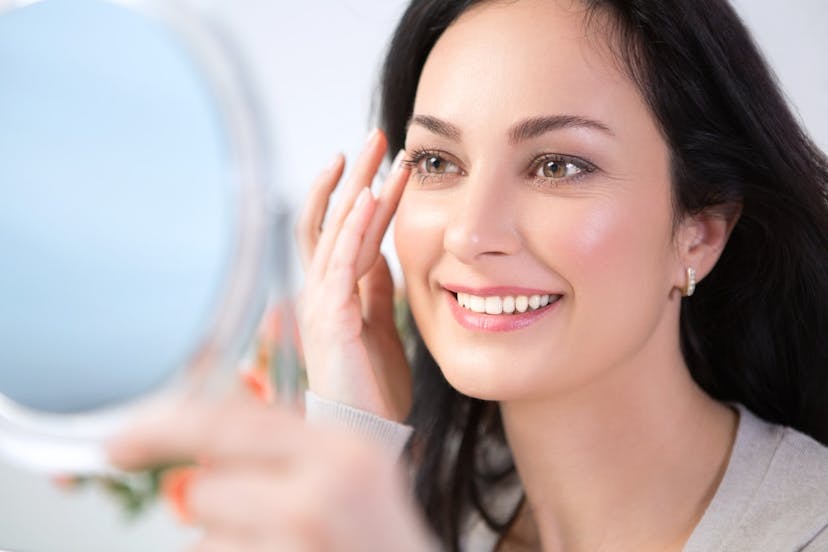
Camera Vs. The Human Eye
Leonardo Da Vinci wrote in his diary “This is the eye, the chief and leader of all others” (1500s). Da Vinci explored the notion of the eye as an optical instrument, and his conceptual search for the science behind sight eventually gathered material momentum with the aid of his various successors.
The Camera Obscura came into being a century later, powered by nothing but sunlight and a biconvex lens.
Camera History
In some sense, this ancient contraption is a scaled-up simplification of the human eye. It is an optical device that projects an image of external surroundings onto an internal blank screen. Light passes through the pinhole, and the biconvex lens flips the image 180 degrees.
Colour and perspective are preserved, and in turn, projected onto a screen on the other side of the room. Think of the dark box room as the interior of an eyeball, and the screen on the back wall as the retina.
Invented by an artist, and used by artists, the camera obscura is essentially a practical extension of the human eye, designed to enhance detail and map reality directly onto paper.
Once in circulation, the camera obscura underwent a variety of alterations. In order to aid drawing, it was reduced to the sizeable convenience of a box, in which a mirror re-reversed the image.~
Throughout its various stages of development, its slight alterations have given rise to a plethora of charming names: Mozi’s “Locked Treasure Room” or “Collecting Plate” became Gaspar Schott’s “Magic Lantern”, and by the 18th Century, it was known as Conte Algarotti’s “Optic Chamber”.

It persists in Modern Culture; in February earlier this year, a model was installed in the New York Public Library. The Oakes brothers, dubbed “The Perspective Twins”, are conducting an exploratory journey into the origins and mechanisms of sight, specifically bifocal visual perception.
Their investigation aims to detail the spherical distortions dictated by the curvature of the eyeball.
If this hasn’t convinced you enough of the wonders of the human lens and its purposes in the field of photography, go and listen to the delightful band “Camera Obscura”, whose name pays homage to this ancient wonder.
Human Eye Vs. Camera
A camera and the human eye both function as optical systems to capture and process visual information, but they do so in slightly different ways. Here's a basic comparison:
- Light Gathering:
- Eye: The human eye gathers light through the cornea, which is the clear front surface of the eye. The cornea focuses light onto the lens.
- Camera: The camera lens serves a similar purpose. It collects light and focuses it onto the camera's sensor or film.
- Focusing:
- Eye: The eye adjusts its focus using the ciliary muscles that change the shape of the lens to focus on objects at different distances (accommodation).
- Camera: The camera lens can be manually or automatically adjusted to change focus.
- Aperture:
- Eye: The pupil acts like the aperture in a camera, adjusting its size to control the amount of light entering the eye.
- Camera: Cameras have an adjustable aperture to control the amount of light reaching the sensor.
- Shutter/Exposure:
- Eye: The retina at the back of the eye contains cells called photoreceptors (rods and cones) that react to light. The exposure time is effectively constant, controlled by the continuous flow of light through the cornea and lens.
- Camera: Cameras use a shutter mechanism to control the exposure time. The shutter opens and closes to allow a specific amount of light to reach the sensor or film.
- Image Formation:
- Eye: The lens focuses the incoming light onto the retina, where it forms an inverted image. The retina then converts this image into electrical signals that are sent to the brain via the optic nerve.
- Camera: The lens focuses the incoming light onto the camera sensor. The sensor converts the light into an electronic signal, which is then processed by the camera's image processor.
- Image Processing:
- Eye: The brain processes the electrical signals received from the retina to construct the final image that we perceive.
- Camera: The camera's image processor performs various tasks such as colour correction, noise reduction, and sometimes even in-camera image enhancements.
- Depth Perception:
- Eye: The human eye can perceive depth and three-dimensional space due to the separation between the eyes, which results in binocular vision.
- Camera: Most cameras use a single lens and sensor, so they don't naturally perceive depth. However, there are techniques like stereo photography that attempt to replicate this.
- Adaptation to Light:
- Eye: The human eye can adapt to a wide range of lighting conditions. This is achieved through the dilation or constriction of the pupil and the adjustment of the sensitivity of the photoreceptors.
- Camera: While modern digital cameras have improved low-light performance, they don't have the same adaptability as the human eye.
In summary, both the human eye and a camera use similar optical principles to capture and process visual information, but there are differences in the mechanisms they use. The human eye is an incredibly complex and versatile biological system that has evolved over millions of years, while a camera is a technological device designed to mimic some of the eye's functions.
Cameras Today
Image Capture
Modern cameras, particularly digital ones, use a combination of advanced optics and electronics to capture images. The primary component is the lens, which gathers and focuses light onto a photosensitive surface called a sensor. This sensor is typically a CMOS (Complementary Metal-Oxide-Semiconductor) or a CCD (Charge-Coupled Device) chip. When light strikes the sensor, it converts the photons into electrical charges, creating a digital representation of the scene. Each pixel on the sensor corresponds to a tiny area of the image, and the varying intensity of light hitting these pixels is recorded.

Image Processing
Once the sensor captures the raw data, it is then processed by the camera's image processor. This processor performs a series of operations including colour interpolation, noise reduction, white balance adjustment, and sometimes even in-camera sharpening and contrast adjustments. These processes enhance the image quality and prepare it for storage or display. Modern cameras also often have specialised modes and settings for different shooting conditions, such as portrait, landscape, low light, and more. Additionally, features like face detection and autofocus algorithms use complex computations to ensure sharp and well-focused images.
Storage and Display
The processed image data is then saved onto a storage medium, usually an SD card or internal memory. This is where the camera's file format and compression settings come into play, determining the size and quality of the saved image. Many cameras also allow users to shoot in RAW format, which retains all the original data captured by the sensor without any in-camera processing. Once the image is stored, it can be viewed on the camera's LCD screen, and in the case of digital cameras, it can also be transferred to a computer or mobile device for further editing or sharing. Some advanced cameras also have built-in Wi-Fi or Bluetooth for seamless connectivity.
Moreover, modern cameras are sophisticated devices that integrate cutting-edge technology to capture, process, and store high-quality images. They combine precision optics with advanced electronics and powerful software to provide users with a wide range of creative options and produce stunning photographs. Additionally, the ongoing advancements in sensor technology, image processing algorithms, and connectivity features continue to push the boundaries of what is achievable with today's cameras.
20 FAQs About The Camera & Human Eye
Similarities
- Optical Systems: Both cameras and the human eye are optical systems designed to capture and process visual information.
- Lens System: Both have a lens that focuses incoming light onto a light-sensitive surface (sensor or retina).
- Image Inversion: Both systems produce an inverted image on their respective sensors (camera) or retina (eye).
- Iris Mechanism: The pupil in the eye and the aperture in a camera control the amount of light entering the system.
- Focusing Mechanism: Both can adjust focus to capture objects at different distances. The eye accomplishes this through the ciliary muscles, while cameras use a focus ring.

Differences
- Accommodation: The human eye can change its focal length dynamically, adapting to different distances without manual adjustment, while a camera lens must be adjusted manually or automatically.
- Aperture Control: In the eye, the pupil size adjusts automatically based on ambient light conditions, while in a camera, the aperture must be set manually.
- Shutter Speed: The eye doesn't have a mechanical shutter; instead, it relies on the continuous flow of light. Cameras have adjustable shutter speeds to control exposure.
- Colour Perception: The human eye is capable of perceiving a broader range of colours and has more nuanced colour discrimination compared to most cameras.
- Night Vision: The eye is better adapted to low-light conditions due to its ability to adjust to different light levels and its high sensitivity to low-light environments.
- Dynamic Range: The human eye has an incredibly wide dynamic range, allowing it to simultaneously perceive detail in bright and dark areas, which can be challenging for many cameras.
- Peripheral Vision: The human eye has a much wider field of view and better peripheral vision compared to most cameras, which have a fixed focal length.
- Depth Perception: The human eye's binocular vision provides depth perception, allowing it to perceive three-dimensional space. Most cameras lack this natural depth perception.
- Adaptability to Light: The human eye can adapt quickly to changes in light intensity, whereas cameras may take time to adjust settings for optimal exposure.
- Autofocus vs. Manual Focus: While some modern cameras have advanced autofocus systems, they still rely on algorithms and sensors to approximate the focusing abilities of the human eye.
- Image Stabilisation: Some advanced cameras have image stabilisation technology to reduce the effects of camera shake, mimicking the eye's natural stabilisation mechanisms.
- Tear Film: The eye has a protective tear film that keeps the cornea moist and provides a clear optical surface, a feature absent in cameras.
- Retina and Sensor Resolution: The human retina has a variable resolution across its surface, with the highest density of photoreceptors in the fovea, while camera sensors have a uniform resolution.
- Instantaneous Processing: The human brain processes visual information instantaneously, whereas a camera may require some time to process and save an image.
- Evolution vs. Technology: The human eye is the result of millions of years of evolution, finely tuned to survival and perception. Cameras are engineered devices that replicate some of the eye's functions, but they lack the adaptability and complexity of the human visual system.
The Human Eye And AI
Modern advancements in camera technology, particularly in conjunction with Artificial Intelligence (AI), have significantly enhanced the capabilities and functionalities of cameras. Here are some key advancements:
- Autofocus and Subject Tracking: AI-powered autofocus systems use algorithms to track and focus on moving subjects more accurately and quickly, ensuring sharp and clear images even in dynamic scenes.
- Scene Recognition and Optimisation: AI can analyse scenes in real-time and adjust settings like exposure, white balance, and contrast to optimise image quality based on the content being captured.
- Face and Eye Detection: AI algorithms can identify and track faces and eyes in the frame, ensuring that portraits are in sharp focus and well-exposed.
- Object Recognition and Segmentation: Cameras can use AI to identify specific objects in a scene, allowing for features like automatic background blurring (bokeh) in portrait mode.
- Image Stabilisation: AI-powered stabilisation can compensate for shaky hands or camera movement, resulting in smoother videos and sharper images, even in low-light conditions.
- Low-Light Photography: AI algorithms can enhance image quality in low-light situations by reducing noise, improving contrast, and increasing overall image brightness.
- Super Resolution: AI can enhance the resolution of images, making them appear sharper and more detailed than what the camera's sensor would naturally capture.
- HDR Imaging: AI can improve High Dynamic Range (HDR) imaging by combining multiple exposures in real-time to capture a wider range of tones, particularly in challenging lighting conditions.
- Semantic Segmentation: This AI technique can identify different elements in an image (e.g., sky, buildings, people) and apply specific adjustments or effects to each segment separately.
- Language and Voice Recognition: Some cameras are integrated with AI-powered voice assistants that allow users to control the camera, set parameters, and even capture images using voice commands.
- Automatic Scene Modes: AI can recognise various scenes (e.g., landscape, portrait, macro) and apply specific settings and adjustments to optimise image quality for each scenario.
- Image and Video Analysis: AI algorithms can analyse content in real-time, enabling features like object tracking, motion detection, and even recognising specific objects or landmarks.
- Facial Expression and Emotion Analysis: Some cameras can use AI to analyse facial expressions and detect emotions, which can be useful in applications like portrait photography.
- Language Translation for Text Recognition: AI can recognise text in an image and, in some cases, translate it into different languages, enabling real-time translation of signs or documents.
- Enhanced Post-Processing: AI-powered post-processing techniques can automatically improve image quality by reducing noise, enhancing details, and adjusting colours.
These advancements showcase how AI is revolutionising camera technology, making them more intelligent, versatile, and capable of capturing high-quality images and videos across a wide range of scenarios and environments.
Find out more by Speaking to our team









